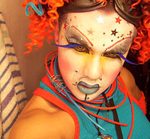Today is World Rock Day. The date of July 13th was established in 1985, as it was the day on which Live Aid took place, a mega charity concert in favor of Ethiopia organized by Bob Geldof and bringing together big names in pop at the time.
And rock, like any musical style, has always welcomed gays. But due to its explosive, aesthetic and aggressive nature, it ended up being more in-your-face than in more serious styles like jazz. Since the early days of rock, stars used to let their hair down on stage and on album covers.
Check out a Top Ten below with some – just a few! – one of the most important examples of the species, which combined at the same time musical quality, a high degree of rock vocation and the issue of explicit homosexuality or bisexuality in lyrics, behavior or appearance.
1.Elton John
The English singer and songwriter only came out completely in the 90s, but his outfits in the 70s already made everything very clear. Including platform shoes and his famous collection of extravagant glasses.
2. David Bowie
The rock chameleon established himself in the early 70s, leading the so-called glam-rock or glitter-rock, full of bands made up of grown men covered in glitter and makeup from head to toe. The fashion was to be bisexual, and Bowie followed the guidebook to the letter. With his playful and extraterrestrial characters, he became an idol for teenagers at the time. Other times?
3. Freddie Mercury
Vocalist of Queen, the singer marked an era in the 70s and 80s with his mannerisms and unforgettable voice. Initially bisexual, Freddie eventually came to admit that he was more gay than bi. He died in 1991, a victim of HIV, but his work remains undaunted and colossal.
4. David Lee Roth
Van Halen's first singer also made history, as one of the first hard rock singers to sing freely. His style inspired dozens of future long-haired, blond and effeminate metalheads – although they were not always gay –, such as Sebastian Bach from Skid Row and Bret Michaels from Poison. Lee Roth even had an adventure with our Brazilian friend Claudia Wonder!
5. Morrissey
The eternal lead singer of the Smiths set the tone for the bibas of the 80s. Fragile, intellectual, introspective and feminine, the singer managed to make even prescription glasses sexy. And his lyrics, both in the Smiths and in his solo phase, always made his sexuality clear, inspired by Oscar Wilde and other tormented millennial gays. Like the hit "This Charming Man", which you see here in a live version.
6. Renato Russo
In Brazil, Renato Russo was considered Morrissey's heir in certain aspects, especially the gay issue. Both at the head of Legião Urbana – often compared to the Smiths – and in his solo career, the artist had a lot in common with the English bard. In the 80s, in lyrics like "Daniel na Cova dos Leões" and "Teorema", Renato insinuated homoeroticism. But it was with "Boys and Girls" that he revealed his bisexuality. In the 90s, he even recorded an album in honor of the Stonewall protest, and later an album in Italian, which features the ballad "Strani Amore", with its super gay clip. Renato died in 1996, a victim of HIV.
7. Michael Stipe
Vocalist of REM, Stipe always maintained a discreet line, but ended up coming out of the closet in the late 90s. For those who knew him from the colorful video for "Shiny Happy People", however, there was no need. Stipe is to this day one of the most respected musicians in North American rock, recorded with REM or other partners.
8. Cazuza
No introduction needed, but whatever. Cazuza remains one of the biggest icons of Brazilian rock and MPB, and of course a gay icon. The singer said he was bisexual since the beginning of his career, as the lead singer of Barão Vermelho, and made everything more explicit in his solo work. As we know, Cazuza died from HIV in 1990.
9. Brian Molko
Appearing at the end of the 90s, Placebo came to represent the new wave of rock bands with androgynous elements, makeup and gothic inspiration. The lead singer of Placebo declares himself bisexual and remains one of the main icons of the (now not so) new rock generation.
10. Brett Anderson
The Suede singer was once considered the Morrissey of the 90s, and became a reference of the period with his bisexuality. Leading Suede, Brett helped create an unforgettable hit that marked the 90s and 2000s and promises to remain an anthem. And it’s worth paying homage to all the artists mentioned on this list. To all of them, "here they come… the BEAUTIFUL ONES".



